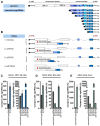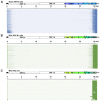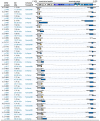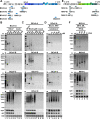Unveiling the biology of defective viral genomes in vitro and in vivo: implications for gene expression and pathogenesis of coronavirus
- PMID: 37803357
- PMCID: PMC10559480
- DOI: 10.1186/s12985-023-02189-7
Unveiling the biology of defective viral genomes in vitro and in vivo: implications for gene expression and pathogenesis of coronavirus
Abstract
Background: Defective viral genome (DVG) is a truncated version of the full-length virus genome identified in most RNA viruses during infection. The synthesis of DVGs in coronavirus has been suggested; however, the fundamental characteristics of coronavirus DVGs in gene expression and pathogenesis have not been systematically analyzed.
Methods: Nanopore direct RNA sequencing was used to investigate the characteristics of coronavirus DVGs in gene expression including reproducibility, abundance, species and genome structures for bovine coronavirus in cells, and for mouse hepatitis virus (MHV)-A59 (a mouse coronavirus) in cells and in mice. The MHV-A59 full-length genomic cDNAs (~ 31 kilobases) were in vitro constructed to experimentally validate the origin of coronavirus DVG. The synthesis of DVGs was also experimentally identified by RT-PCR followed by sequencing. In addition, the alterations of DVGs in amounts and species under different infection environments and selection pressures including the treatment of antiviral remdesivir and interferon were evaluated based on the banding patterns by RT-PCR.
Results: The results are as follows: (i) the structures of DVGs are with diversity, (ii) DVGs are overall synthesized with moderate (MHV-A59 in cells) to high (BCoV in cells and MHV-A59 in mice) reproducibility under regular infection with the same virus inoculum, (iii) DVGs can be synthesized from the full-length coronavirus genome, (iv) the sequences flanking the recombination point of DVGs are AU-rich and thus may contribute to the recombination events during gene expression, (v) the species and amounts of DVG are altered under different infection environments, and (vi) the biological nature of DVGs between in vitro and in vivo is similar.
Conclusions: The identified biological characteristics of coronavirus DVGs in terms of abundance, reproducibility, and variety extend the current model for coronavirus gene expression. In addition, the biological features of alterations in amounts and species of coronavirus DVGs under different infection environments may assist the coronavirus to adapt to the altered environments for virus fitness and may contribute to the coronavirus pathogenesis. Consequently, the unveiled biological features may assist the community to study the gene expression mechanisms of DVGs and their roles in pathogenesis, contributing to the development of antiviral strategy and public health.
Keywords: Coronavirus; Coronavirus genome structure; Defective viral genome; Gene expression; Pathogenesis.
© 2023. BioMed Central Ltd., part of Springer Nature.
Conflict of interest statement
The authors declare that they have no competing interests.
Figures








Similar articles
-
Identification of the protein coding capability of coronavirus defective viral genomes by mass spectrometry.Virol J. 2023 Dec 7;20(1):290. doi: 10.1186/s12985-023-02252-3. Virol J. 2023. PMID: 38062493 Free PMC article.
-
Biological characterization of coronavirus noncanonical transcripts in vitro and in vivo.Virol J. 2023 Oct 12;20(1):232. doi: 10.1186/s12985-023-02201-0. Virol J. 2023. PMID: 37828527 Free PMC article.
-
Generation and Functional Analysis of Defective Viral Genomes during SARS-CoV-2 Infection.mBio. 2023 Jun 27;14(3):e0025023. doi: 10.1128/mbio.00250-23. Epub 2023 Apr 19. mBio. 2023. PMID: 37074178 Free PMC article.
-
Defective viral genomes: advances in understanding their generation, function, and impact on infection outcomes.mBio. 2024 May 8;15(5):e0069224. doi: 10.1128/mbio.00692-24. Epub 2024 Apr 3. mBio. 2024. PMID: 38567955 Free PMC article. Review.
-
The Impact of Defective Viruses on Infection and Immunity.Annu Rev Virol. 2019 Sep 29;6(1):547-566. doi: 10.1146/annurev-virology-092818-015652. Epub 2019 May 13. Annu Rev Virol. 2019. PMID: 31082310 Review.
Cited by
-
Coronavirus Replication: Genomes, Subgenomic RNAs, and Defective Viral Genomes.Viruses. 2025 May 28;17(6):767. doi: 10.3390/v17060767. Viruses. 2025. PMID: 40573357 Free PMC article. Review.
-
Identification of the protein coding capability of coronavirus defective viral genomes by mass spectrometry.Virol J. 2023 Dec 7;20(1):290. doi: 10.1186/s12985-023-02252-3. Virol J. 2023. PMID: 38062493 Free PMC article.
-
Diverse effects of coronavirus-defective viral genomes on the synthesis of IFNβ and ISG15 mRNAs and coronavirus replication.Virol J. 2025 Feb 14;22(1):37. doi: 10.1186/s12985-025-02654-5. Virol J. 2025. PMID: 39953551 Free PMC article.
-
Preferential cleavage of the coronavirus defective viral genome by cellular endoribonuclease with characteristics of RNase L.Virol J. 2024 Nov 1;21(1):273. doi: 10.1186/s12985-024-02549-x. Virol J. 2024. PMID: 39487538 Free PMC article.
-
Cellular dynamics shape recombination frequency in coronaviruses.PLoS Pathog. 2024 Sep 27;20(9):e1012596. doi: 10.1371/journal.ppat.1012596. eCollection 2024 Sep. PLoS Pathog. 2024. PMID: 39331680 Free PMC article.
References
Publication types
MeSH terms
Substances
LinkOut - more resources
Full Text Sources

